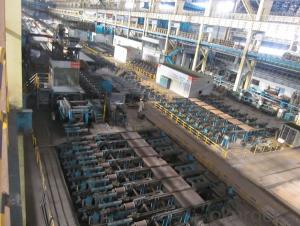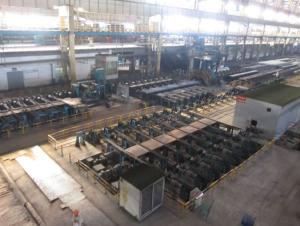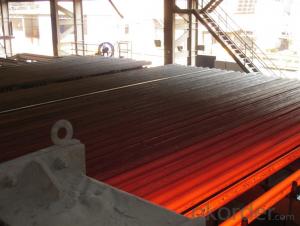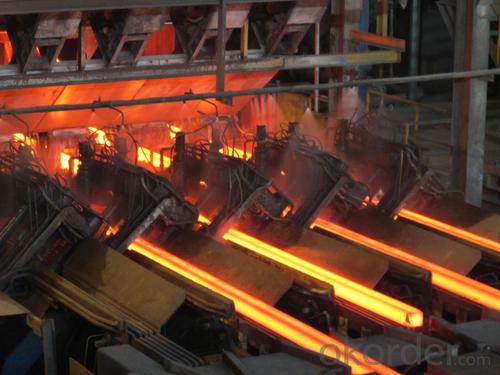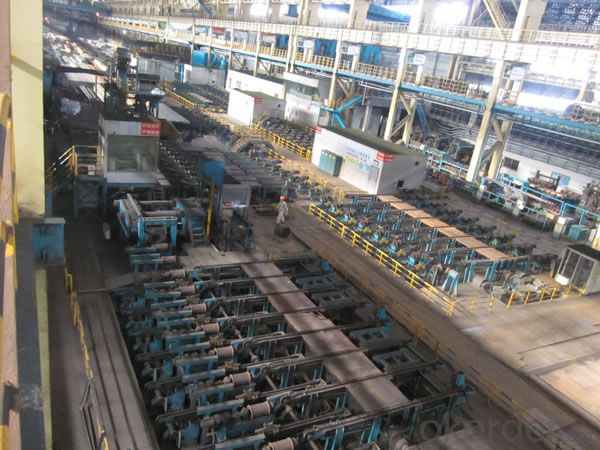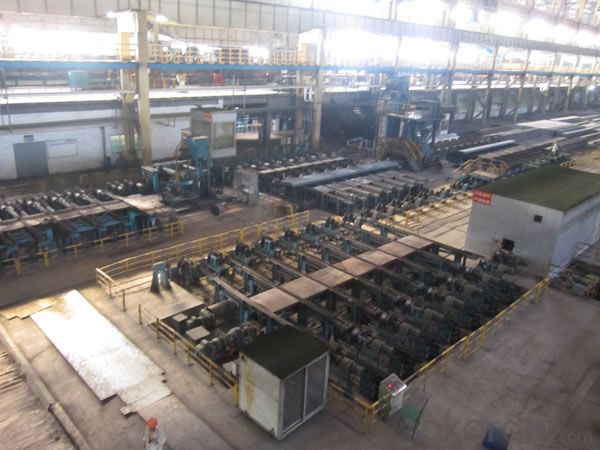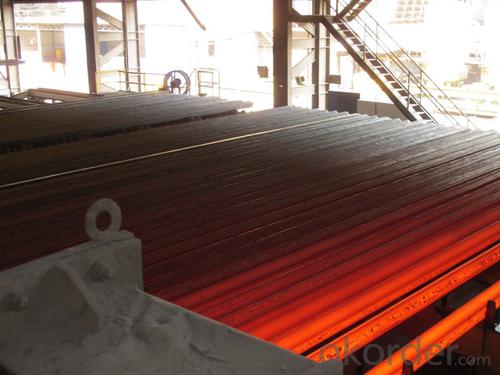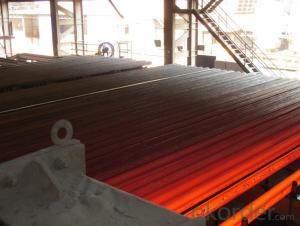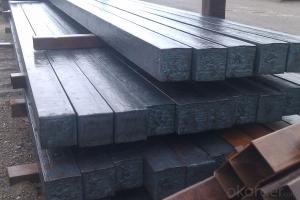Prime quality square alloy steel billet 85mm Q235
- Loading Port:
- Tianjin
- Payment Terms:
- TT OR LC
- Min Order Qty:
- 100 m.t.
- Supply Capability:
- 10000 m.t./month
OKorder Service Pledge
OKorder Financial Service
You Might Also Like
Structure of Prime quality square alloy steel billet 85mm Q235

Description of Prime quality square alloy steel billet 85mm Q235
1. Prepainted steel coil is coated with organic layer, which provides higher anti-corrosion property and a longer lifespan than that of galvanized or galvalume steel sheets.
2. The base metals for prepainted steel coil consist of cold rolled, HDGI Steel, electro-galvanized and hot-dip alu-zinc coated steel. The finish coats of prepainted steel coil can be classified into groups as follows: polyester, silicon modified polyesters, polyvinylidene fluoride, high-durability polyester, etc.
3. The production process has evolved from one-coating-and-one-baking to double-coating-and-double-baking, and even three-coating-and-three-baking.
4. The color of the prepainted steel coil has a very wide selection, like orange, cream-colored, dark sky blue, sea blue, bright red, brick red, ivory white, porcelain blue, etc.
5. The prepainted steel coils can also be classified into groups by their surface textures, namely regular prepainted sheets, embossed sheets and printed sheets.

Main Feature of Prime quality square alloy steel billet 85mm Q235
Uncoated CR steel sheet
With the features of in line with the international highest standards in demension and shape, excellent surface finish and properties, the products are mainly used in home appliance and automobile industries.
Galvanized steel sheet(include HDG and EG)
With the features of good corrosion resistance, the products are mainly used in automobile, home appliance, electronics, building and machinery manufacture industries, etc.
Precoated steel sheet
With the features of enviromental protection and good processablility, long lasting surface durability, rich in colors, the products are maily used in building, home appliance and furniture industries, etc.
Applications of Prime quality square alloy steel billet 80mm Q235
Construction
Manufacture anticorrosion, industrial and civil architecture roof boarding, roof grille
Light industries
Home appliance's case, civil chimney, kitchen utensils
Auto industry
Corrosion resistant parts of cars
Agriculture
Food storage, meat and aquatic products' freezing and processing equipment
Commerce
Equipments to store and transport materials, and packing implements

Specifications of Prime quality square alloy steel billet 85mm Q235
Product | Prime quality square alloy steel billet 85mm Q235 |
Material Grade | SGCC / SGCH / DX51D+AZ, etc |
Thickness | 0.6-3.0mm |
Width | 500-1500mm |
Tolerance | Thickness: +/-0.02mm , Width:+/-2mm |
Zinc-coating | Z30-150g/m2 |
Technique | Raw material: Hot rolled steel coil --> Cold rolled_>hot dipped galvalume |
Surface | Dried, Chromated, Unoiled |
Spangle | Regular spangle , small spangle, zero spangle |
ID | 508MM 610MM |
Coil weight | 1-25MT |
Export package | Cardboard inner sleeves, Waterproof paper, galvanized steel covered and steel strip packed |
FAQ of Prime quality square alloy steel billet 85mm Q235
We have organized several common questions for our clients,may help you sincerely:
1. How Can I Visit There?
Our company is located in Tianjin City, China, near Beijing. You can fly to Tianjin Airport Directly. All our clients, from home or aboard, are warmly welcome to visit us!
2. How Can I Get Some Sample?
We are honored to offer you sample.
3. Why choose CNBM?
Our delivery time about 15-20days for standard sizes, if you have other requirements like hardness, quanity and width ,it is about 20-40days. But don't worry we also try our best for the delivery time ,because time longer and our cost is higher.
- Q: Are steel billets used in the manufacturing of construction machinery?
- Yes, steel billets are commonly used in the manufacturing of construction machinery. Steel billets are semi-finished products that are used as raw materials in various industries, including construction machinery manufacturing. These billets are typically made from molten steel that is cast into a solid form and then further processed to shape and size. Due to their high strength, durability, and versatility, steel billets are ideal for constructing heavy-duty components and structures in construction machinery. They can be used to manufacture various parts such as chassis, frames, buckets, booms, and arms, among others. The use of steel billets ensures that construction machinery is capable of withstanding the demanding conditions and heavy loads commonly encountered in construction projects.
- Q: How do steel billets contribute to the manufacturing of marine gear?
- Steel billets contribute to the manufacturing of marine gear by serving as the raw material for the production of various components, such as gears, shafts, and bearings. These billets are first heated and then shaped through forging or machining processes to create the desired gear components with high strength and durability. The use of steel billets ensures that the marine gear can withstand the harsh conditions of marine environments, such as corrosion, high loads, and extreme temperatures, ultimately enhancing the performance and reliability of the gear in marine applications.
- Q: What is the difference between continuous casting billet and cast billet?
- Mainly to see the process, general casting efficiency is low, but the quality is acceptable, with low level (open casting billet) has great advantages in surface quality;
- Q: What are the main factors affecting the dimensional accuracy of steel billets?
- The main factors affecting the dimensional accuracy of steel billets include the quality of the raw materials used, the temperature and cooling rate during the casting process, the design and condition of the casting equipment, and the skill and experience of the operators.
- Q: Can steel billets be used in the production of agricultural equipment?
- Yes, steel billets can be used in the production of agricultural equipment. Steel billets are semi-finished products that are typically cast in a continuous casting process. They can be further processed into various shapes and sizes to manufacture agricultural equipment such as plows, cultivators, harrows, seeders, and other farm machinery. The use of steel billets in agricultural equipment offers several advantages. Steel is known for its strength, durability, and resistance to wear and tear, making it suitable for heavy-duty applications in the agricultural industry. Additionally, steel can withstand harsh environmental conditions, ensuring that the equipment remains reliable and functional even in challenging farming environments. Moreover, steel can be easily molded and fabricated into different forms, allowing for the customization of agricultural equipment to meet specific requirements. Overall, the use of steel billets in the production of agricultural equipment contributes to the efficiency, productivity, and longevity of farming operations.
- Q: How are steel billets used in the manufacturing of bridges?
- Steel billets are crucial for bridge manufacturing as they act as the starting point for creating different structural elements. Usually rectangular or square, these billets are heated and rolled in mills to form various sections like beams, columns, and girders. After being rolled into the desired shape, the steel billets go through further processing to enhance their strength and durability. This involves heat treatment and quenching processes to improve mechanical properties such as hardness and toughness. Additionally, surface treatments are applied to protect against corrosion, ensuring the bridge's longevity. The shaped and treated steel sections derived from these billets are then assembled and welded together to create the bridge's framework. These structural elements provide the necessary load-bearing capacity and stability to support the bridge's weight, as well as withstand external forces like traffic loads, wind, and seismic activity. Moreover, steel billets are vital for constructing bridge piers and abutments, which offer support and anchorage. These components are often reinforced with steel bars or rebar, produced from billets, to increase their strength and ability to withstand vertical and horizontal forces. In conclusion, steel billets are essential raw materials for manufacturing bridges. Through rolling, shaping, heat treatment, and surface treatment processes, these billets are transformed into beams, columns, and other sections that form the bridge's framework. The resulting steel components provide the necessary strength, durability, and load-bearing capacity for the construction of safe and reliable bridges.
- Q: What are the environmental impacts of producing steel billets?
- The production of steel billets has various environmental consequences. One of the primary concerns lies in the emission of greenhouse gases, particularly carbon dioxide (CO2), during the steelmaking process. Steel production significantly contributes to global CO2 emissions due to the high temperatures and the utilization of fossil fuels like coal or natural gas to extract iron from iron ore. The combustion of these fuels releases CO2 into the atmosphere, thereby contributing to climate change. Another environmental impact associated with steel billet production is the generation of air pollutants. The use of fossil fuels in steelmaking can lead to the release of sulfur dioxide (SO2), nitrogen oxides (NOx), and particulate matter, which contribute to air pollution and can negatively affect human health. Moreover, the production of steel billets often involves the use of additives and chemicals, which can further contribute to air pollution if not appropriately managed. The extraction of iron ore, a primary raw material for steel production, can also have significant environmental implications. Mining activities can result in deforestation, habitat destruction, and soil erosion. Additionally, the extraction and transportation of iron ore necessitate the use of heavy machinery and vehicles, consuming energy and contributing to air pollution. Water usage is another environmental concern in the production of steel billets. Steelmaking processes require substantial amounts of water for cooling, cleaning, and dust suppression. The extraction and treatment of water, as well as the discharge of wastewater, can have adverse effects on local water sources, particularly if not properly managed or treated. Lastly, the production of steel billets generates waste and by-products. Steel slag, a by-product of the steelmaking process, can contain heavy metals and other pollutants. If not adequately treated or disposed of, these by-products can contaminate soil and water resources. In summary, the production of steel billets has significant environmental impacts, including greenhouse gas emissions, air pollution, water usage, and the generation of waste and by-products. Efforts are being made to mitigate these impacts through the development of cleaner and more energy-efficient steelmaking technologies, increased utilization of recycled steel, and improved waste management practices in the industry.
- Q: What is the average weight of a steel billet?
- The size and dimensions of a steel billet can cause variations in its average weight. Nevertheless, a standard steel billet generally ranges from 1,000 kilograms (2,204 pounds) to 5,000 kilograms (11,023 pounds). These weight ranges are commonly observed in industrial-grade steel billets utilized in diverse manufacturing techniques like forging, rolling, and extrusion. It should be emphasized that the weight of a steel billet can be tailored according to specific necessities and industry norms.
- Q: What are the main factors affecting the dimensional stability of steel billets?
- There are several main factors that can affect the dimensional stability of steel billets. 1. Temperature: One of the most significant factors is temperature. Steel billets can undergo thermal expansion or contraction depending on the temperature they are exposed to. Changes in temperature can cause the billets to expand or contract, leading to dimensional changes. It is crucial to control the temperature during the manufacturing process and subsequent cooling stages to minimize these effects. 2. Cooling rate: The rate at which the steel billets cool down after being heated also affects their dimensional stability. Rapid cooling can result in internal stresses within the billet, causing it to warp or distort. On the other hand, slow cooling can lead to uneven cooling and uneven dimensional changes. 3. Composition: The chemical composition of the steel billets plays a significant role in their dimensional stability. Different alloying elements, impurities, and carbon content can influence the material's behavior during heating and cooling. For instance, higher carbon content can increase the likelihood of warping or distortion. 4. Mechanical stresses: Mechanical stresses from handling, transportation, or machining processes can impact the dimensional stability of steel billets. Excessive bending, twisting, or pressure can cause permanent deformation or residual stresses within the billet, affecting its overall dimensional stability. 5. Heat treatment: The heat treatment process can also influence the dimensional stability of steel billets. Different heat treatment methods, such as annealing, quenching, or tempering, can introduce internal stresses or phase transformations that may alter the billet's dimensions. 6. Manufacturing techniques: The processes used during the production of steel billets, such as casting, rolling, or forging, can have an impact on their dimensional stability. Inadequate control or inconsistencies in these manufacturing techniques can lead to variations in the billet's dimensions. It is crucial to consider and control these factors to ensure the dimensional stability of steel billets, as any dimensional changes can affect the subsequent processing steps and the final product's quality.
- Q: How are steel billets inspected for quality?
- Steel billets are typically inspected for quality using various non-destructive testing methods such as visual inspection, ultrasonic testing, magnetic particle inspection, and dye penetrant testing. These tests help identify any surface defects, cracks, or internal flaws in the billets, ensuring that they meet the required quality standards before further processing.
Send your message to us
Prime quality square alloy steel billet 85mm Q235
- Loading Port:
- Tianjin
- Payment Terms:
- TT OR LC
- Min Order Qty:
- 100 m.t.
- Supply Capability:
- 10000 m.t./month
OKorder Service Pledge
OKorder Financial Service
Similar products
Hot products
Hot Searches
Related keywords



